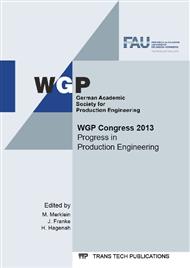p.34
p.42
p.53
p.61
p.69
p.77
p.85
p.93
p.101
A High Resolution Surface Model for the Simulation of Honing Processes
Abstract:
The demand for highly resistant surfaces is driven by the requirement for resource efficiency and rising environmental concerns. Finishing processes like long-stroke honing for the machining of boreholes of chuck components make it possible to create surfaces with favourable tribological properties. Since variations of process parameter values have complex effects on the resulting workpiece topography and its characteristic values, many experiments might be necessary to achieve certain properties. To avoid this, a simulation-based approach has been developed that relies on a high resolution model of the tool and the workpiece. For its calibration and validation, systematic investigations of a honing process and the machining parameter values have been conducted, and the measured surfaces are compared to the computed workpiece topographies.
Info:
Periodical:
Pages:
69-76
Citation:
Online since:
September 2013
Authors:
Keywords:
Price:
Сopyright:
© 2013 Trans Tech Publications Ltd. All Rights Reserved
Share:
Citation:


